
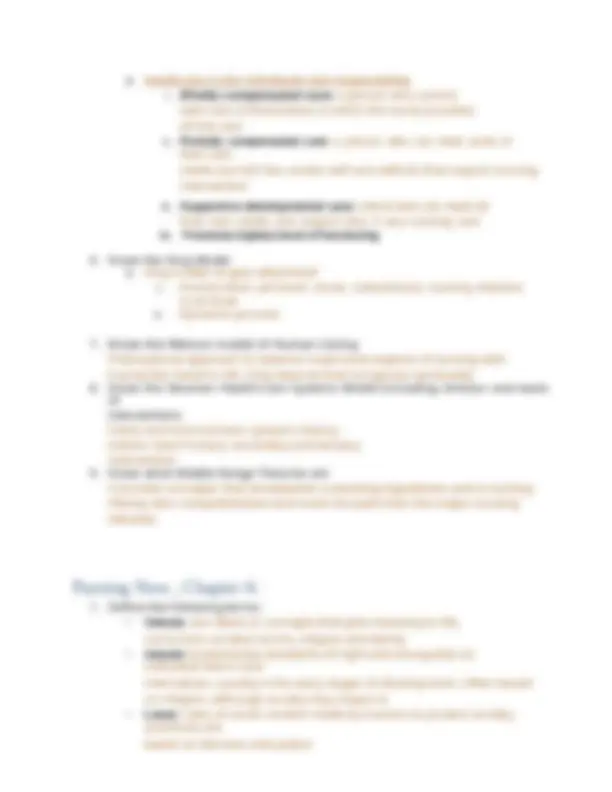
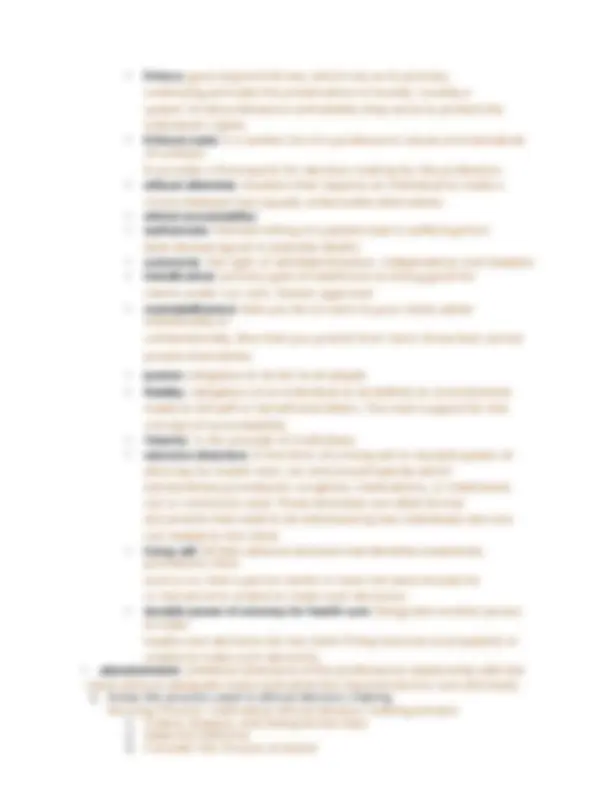
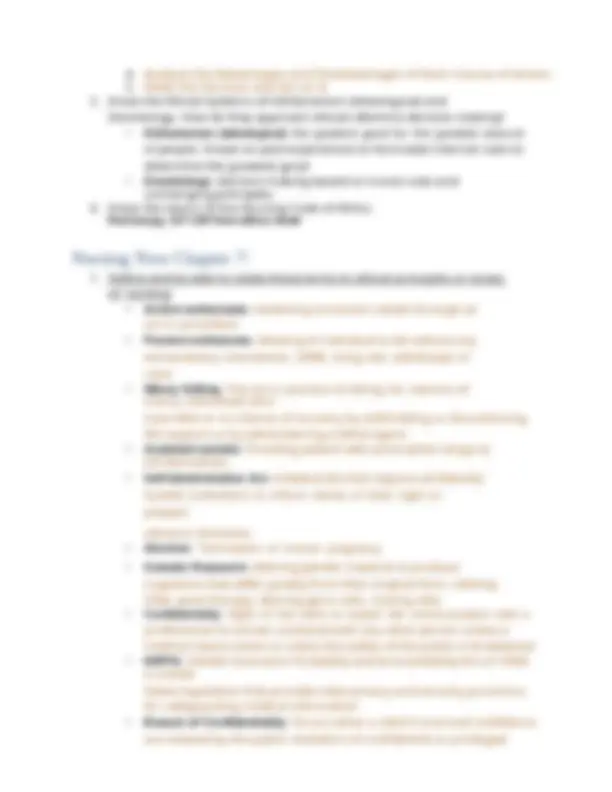
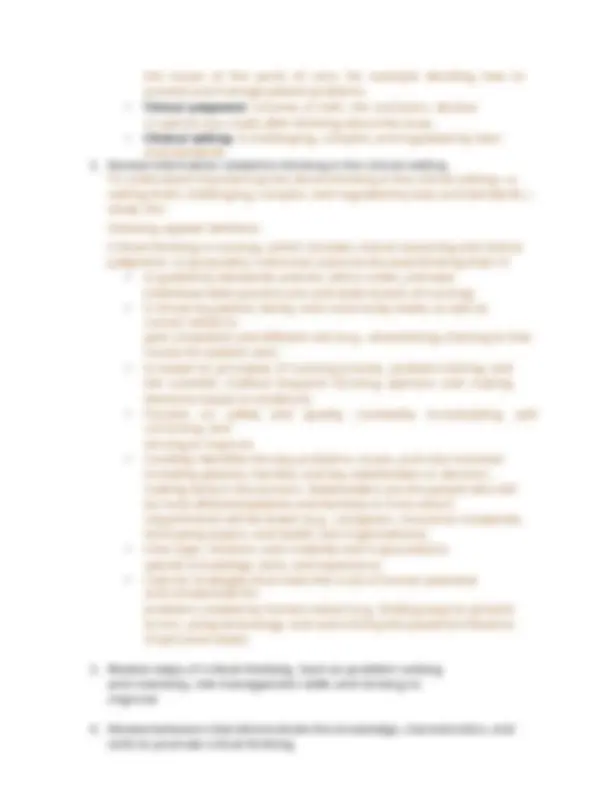
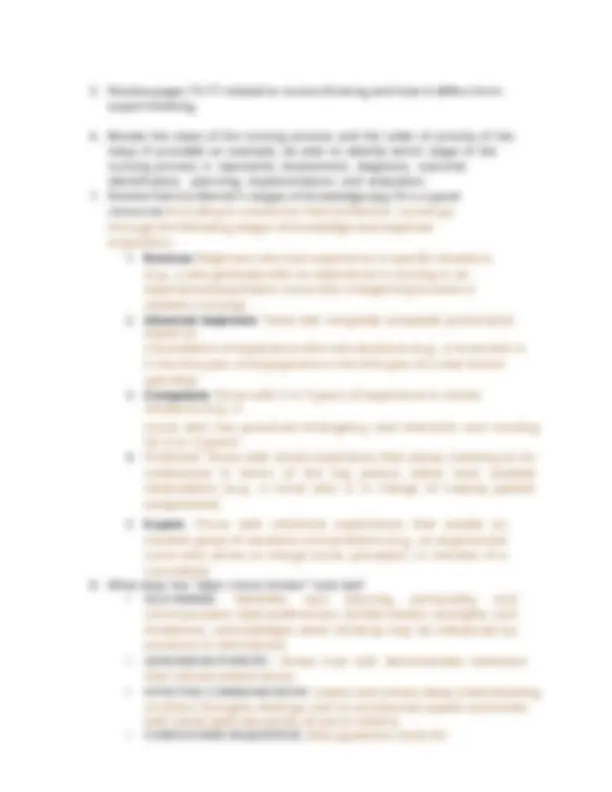
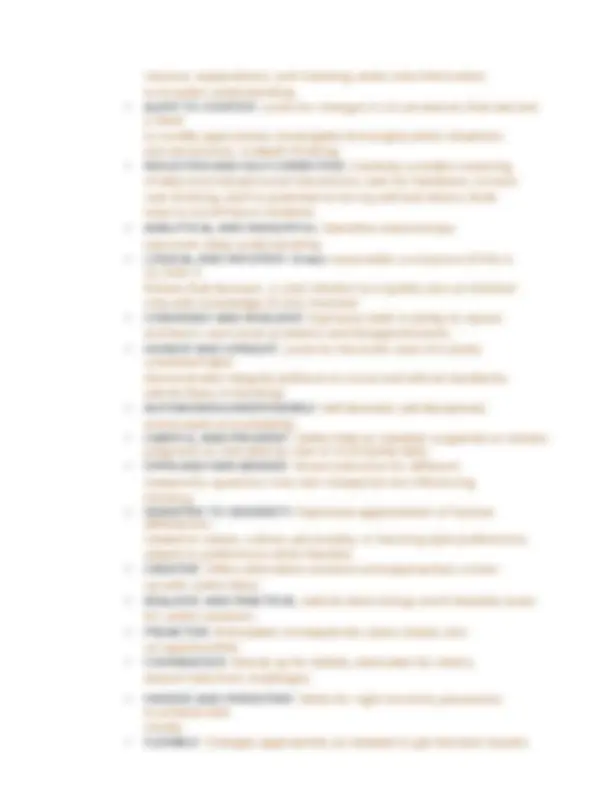
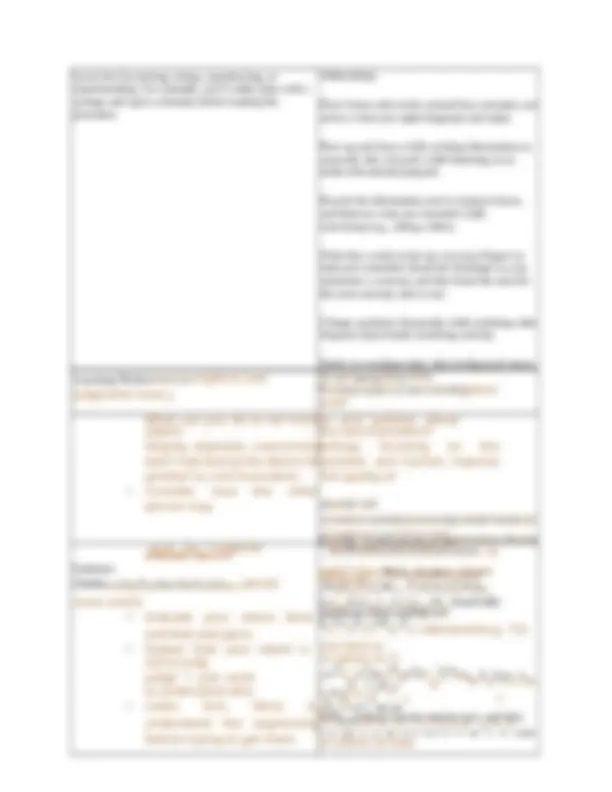
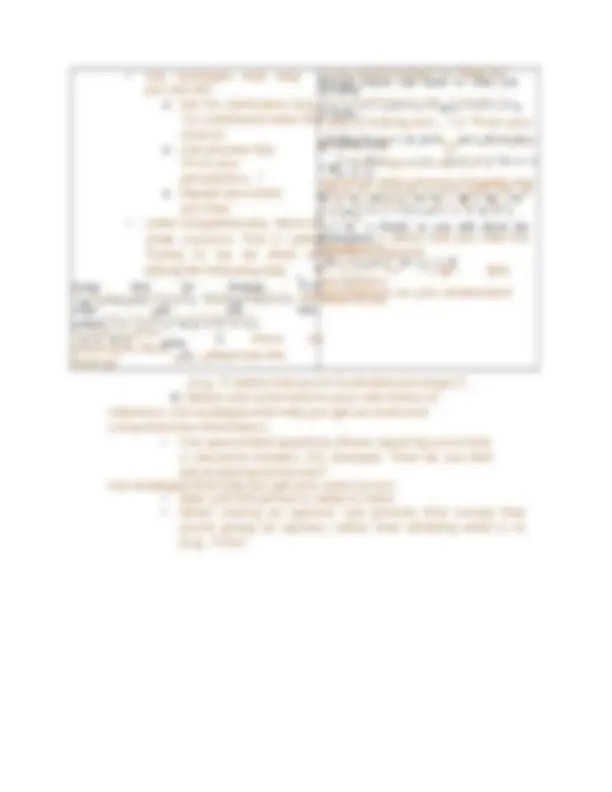



Study with the several resources on Docsity

Earn points by helping other students or get them with a premium plan


Prepare for your exams
Study with the several resources on Docsity

Earn points to download
Earn points by helping other students or get them with a premium plan
Community
Ask the community for help and clear up your study doubts
Discover the best universities in your country according to Docsity users
Free resources
Download our free guides on studying techniques, anxiety management strategies, and thesis advice from Docsity tutors
Nur2058 Study Guide Exam 2Nur2058 Study Guide Exam 2
Typology: Exams
1 / 16

This page cannot be seen from the preview
Don't miss anything!










Nursing Now Chapter 3
observed behaviors and their effects on a client’s health. In
nursing, the goal is to describe and explain a particular nursing
action to make a hypothesis.
in reality. The
purpose is to explain a complex reality in a systematic and organized
manner.
In nursing, the goal is to describe and explain a particular nursing action to
make a hypothesis, which predicts the effects on a client’s outcome, such as
improved health or recovery from illness.
client who is the primary receipt of nursing care.
continuum, ranging from
completely healthy state in which there is no disease to completely
unhealth state, which results in death.
the elements
such as living conditions, public sanitation and air and water quality
as well as interpersonal relationships and social interactions.
relationships with
clients that affect client’s health
General Systems Theory is an organized unit with a set of components
that interact and affect each other, a system acts as a whole because of
interdependence of its parts
functioning by restricting or increasing input/output and maintain
the high level of functioning.
underlying principle the preservation of society. Usually a
system of value behaviors and beliefs; they serve to protect the
individual’s rights.
of conduct.
It provides a framework for decision making for the profession.
choice between two equally unfavorable alternatives
fatal disease (good or peaceful death)
clients under our care. Holistic approach
intentionally or
unintentionally. Also that you protect from harm those that cannot
protect themselves
made to himself or herself and others. The main support for the
concept of accountability.
attorney for health care, can and should specify which
extraordinary procedures, surgeries, medications, or treatments
can or cannot be used. These directives are often formal
documents that need to be witnessed by two individuals who are
not related to the client.
procedures, tests,
and so on, that a person wants or does not want should he
or she become unable to make such decisions.
to make
health-care decisions for the client if they become incompetent or
unable to make such decisions.
client without adequate notice and while the requirement for care still exists.
Nursing Process: methodical ethical decision making process
Deontology. How do they approach ethical dilemma decision making?
of people. Draws on past experiences to formulate internal rules to
determine the greatest good
unchanging principles.
Review pg. 137-139 from ethics book
Nursing Now Chapter 7:
of nursing:
act or procedure
extraordinary intervention. (DNR, living will, withdrawal of
care)
mercy, individuals who
have little or no chance of recovery by withholding or discontinuing
life support or by administering a lethal agent.
kill themselves.
funded institutions to inform clients of their right to
prepare
advance directives.
organisms that differ greatly from their original form, refining
DNA, gene therapy, altering germ cells, cloning cells.
professional to remain unshared with any other person unless a
medical reason exists or unless the safety of the public is threatened.
is United
States legislation that provides data privacy and security provisions
for safeguarding medical information
are violated by the public revelation of confidential or privileged
restrained with intent to prevent him or her from leaving
the hospital.
society
deals with violation of ones rights by an individual
chart about
patients and their care. (Remember with documentation, only state the
facts! No personal opinion)
SBAR: Situation, background, assessment, recommendation
directive, DNR orders are legally separate from advance directives.
For the health-care professional to be legally protected, there
should be a written order for a “no code” or a DNR order in the
client's chart
or uses
language that harms another person’s reputation.
another in terms that harm that person’s reputation.
the dignity
and freedom of humans
ethical issue. Informed consent is the voluntary permission
by a client or by the client's designated proxy to carry out a
procedure on the client
Critical Thinking, Clinical Reasoning and Clinical Judgment,
Chapters 1-
clinical judgment (pages 70- 72 are good resources)
carefully evaluating it. You examine assumptions, evaluate evidence
and uncover underlying values and reasons.
the issues at the point of care- for example deciding how to
prevent and manage patient problems.
or opinion you make after thinking about the issue.
and standards
To understand important points about thinking in the clinical setting—a
setting that’s challenging, complex, and regulated by laws and standards—
study the
following applied definition.
Critical thinking in nursing—which includes clinical reasoning and clinical
judgment—is purposeful, informed, outcome-focused thinking that:
(individual state practice acts and state boards of nursing).
nurses’ needs to
give competent and efficient care (e.g., streamlining charting to free
nurses for patient care).
the scientific method (requires forming opinions and making
decisions based on evidence).
correcting, and
striving to improve.
including patients, families, and key stakeholders in decision-
making early in the process. Stakeholders are the people who will
be most affected (patients and families) or from whom
requirements will be drawn (e.g., caregivers, insurance companies,
third-party payers, and health care organizations).
specific knowledge, skills, and experience.
and compensate for
problems created by human nature (e.g., finding ways to prevent
errors, using technology, and overcoming the powerful influence
of personal views).
and creativity, risk management skills and striving to
improve
skills to promote critical thinking
reasons, explanations, and meaning; seeks new information
to broaden understanding.
a need
to modify approaches; investigates thoroughly when situations
warrant precise, in-depth thinking.
of data and interpersonal interactions, asks for feedback; corrects
own thinking, alert to potential errors by self and others, finds
ways to avoid future mistakes.
expresses deep understanding.
so, then it
follows that because…); uses intuition as a guide; acts on intuition
only with knowledge of risks involved.
and learn; overcomes problems and disappointments.
unwanted light;
demonstrates integrity (adheres to moral and ethical standards;
admits flaws in thinking).
and accepts accountability.
judgment as indicated by new or incomplete data.
viewpoints; questions how own viewpoints are influencing
thinking.
differences
related to values, culture, personality, or learning style preferences;
adapts to preferences when feasible.
up with useful ideas.
for useful solutions.
on opportunities.
doesn’t hide from challenges.
to achieve best
results.
healthy behaviors to manage stress.
learning needs; finds ways to overcome limitations, seeks out new
knowledge. Patients—Promotes health; maximizes function,
comfort, and convenience.
Systems—Identifies risks and problems with health care systems;
promotes safety, quality, satisfaction, and cost containment.
emotional intelligence? Definition: Knowing how to recognize
and manage emotions to get positive results.
through dialogue, help others to do the same (“I feel…
because….” If you’re trying to connect with others’ emotions, ask
“What are your thoughts and feelings on this?”). Never assume
you know what someone else is feeling. Never expect others to
know what you’re feeling.
what he or she feels.
connecting with how emotions are affecting thinking. Learn to
manage feelings like anger, anxiety, fear, and discouragement.
of behavior are what matter. Don’t sweat the small
stuff.
you may trigger depression in someone else. If you’re
enthusiastic, you may trigger enthusiasm.
out, focus on the positives, find a sense of humor, play a game, or
take a walk.
Learning Preference Strategies to Promote Learning
relationships.
Draw boxes and circles around key concepts; use
arrows when you make diagrams and maps.
Pace up and down while reciting information to
yourself; ride a bicycle while listening to an
audio educational program.
Record the information you’re trying to learn,
and listen to what you recorded while
exercising (e.g., riding a bike).
Write key words in the air; use your fingers to
help you remember (bend the forefinger as you
memorize a concept, and then bend the next for
the next concept, and so on).
Change positions frequently while studying; take
frequent short breaks involving activity.
Study in a rocking chair; play background music.
Learn best by moving, doing, experiencing, or
experimenting. For example, you’d rather play with a
syringe and inject a dummy before reading the
procedure.
Learning Prefere
a n
s c
s e
umptions and
judgments have y
l
o S
u tr
m ate
a g
d i
e es
t
o
Phraotm’soyteouLreacronninfigdence
evel?
What can you do to be more
objecti
Staying objective, overcoming
bad f expressing the desire for
positive ou communication.
person may
ve and positive about
the communication?
eelings, focusing on the
present, and tcomes improve
the quality of
p s
e k
rc i
e f
iyvoeubcoatnhdyooaussaignndmthenetssiit
n
ua an
tio a
n ct
iv
e
h w
in a
k y
o e
s r
t e
e n
r, c
b e
e s
p
c
a
o
b
m
ou
m
t cultural
differences and
Listeners
(Audito
m
ry
ak
e
ea
th
rn
e
er
o
s
t
her
person
more comfor
and that and place.
not to judg
judge. I just want
to understand wha
understand the expressing
before trying to get them
u
e n
.g ic
a
c t
r io
ea n
te p
a re
p f
a W
rt h
o a
f t
a c
d a
i n
sc y
u o
ss u
io d
n o to
table? Use clear, concise, simple
language. o
f
h
th
is
e
pe
o
r
th
a
e
s
r
yo
p
u
er
r
s
e
o
ad
n
l
is
h
te
o
n
o
in
s
g
e
t
t
o
he
yo
r
u
ig
r
h
w
t
o
t
r
im
ds
e
(especially
important when reading test
q
e
u
e
b
st
u
i
t
on
to
s)
u
nderstand (e.g., “I’m
not here to
t’s going on.”).
f
tw
h
e
io
s
thu
l
te
go
n
uh
g
i
tt
n
tsa
th
k
a
in
t
g
o
n
th
o
e
te
r
s
c
a,
l
n
as
d
s
a
fo
r
c
e
us
i
i
n
ng on
s s
unde
e
anding what the teacher says, and then
rst
c
t
o
o
py
u
s
n
o
d
m
e
e
r
o
s
n
t
e
a
e
n
l
d
se’
y
s
o
n
u
o
tes.
er points of view.
you see oth
o Ask for clarification (e.g.,
“Ca understand what the
most im
o Use phrases like,
“From you
perspective….”
o Repeat back what
you hear
unde concerns. This is called
“trying to wa be done by
taking the following step
Learn best by hearing.
o
ex
le
a
a
m
r
p
y
le
o
u
y
r
o
m
u
i
l
n
e
d
arn
of
b
t
e
h
s
o
t
ugh
when you can liste
withou
c
t
o
w
n
o
c
r
e
r
r
y
n
in
s
g
a
a
b
b
o
o
u
u
t
t
h
ta
o
k
w
in
y
g
ou’re
notes.
listening to the p
a
n
d
Rephrase the
feelings
n you clarify further?” or “Help me
Record classes and listen to what you
recorded
t
p o rt a n
t
t i s s
e
u e
im
s
e
a r e .”
f
r
w o o r h r e t s b e o
e exams.
r way of looking at it….” or “From your
a
n
sk i
e
f y
o
g
u c
an
gi
ve
g
o
an o
u
ra
l
r
re
e
por
s
t
o
a
r
y
han
i
d
n
in
c
a
u
Is
di
t
o
hat c
r
o
e
rre
p
c
o
t?
r
t
fo r e x
t ra
re d it.
rstand the other person’s struggles and
lk
e
a
m
m
or
i
i
l
z
e
e
in
by
s
m
om
ak
e
i
o
ng
ne
up
el
s
s
o
e
n
g
s
s
s
o
h
r
o
r
e
h
s
y
m
a
e
n
s.
d
c
tu
a
d
n
y
s
w
i
th
a friend, so you talk about the
information. s about how you view the
r
situation or
t going to respond.
n
R e
s
c o r
d y
e
ou r s
n
e
g
lf
and
e r o n s f e li s
perceptions.
perceptions as you understand
them to be
(e.g., “I realize that you’re frustrated and angry.”).
reference. Use strategies that help you get accurate and
comprehensive information.
a one-word answer). For example, “How do you feel
about leaving tomorrow?”
Use strategies that help you get your point across:
you’re giving an opinion, rather than dictating what is so
(e.g., “From
Open Ended Questions from All Chapters
nursing model that helped to balance impersonal parts of nursing
(technological, scientific) with the personal and interpersonal aspects of
care because she wanted to recognize the client and family spiritual
beliefs.
important in the
practice of nursing:
focused, yet not as specific or concrete as some theories.
about health care
are written in the case they are unable to make decisions for themselves,
this document is can be called (Select all that apply)
there is a choice between two equally unfavorable alternatives.
with negligence.
care professionals under the Good Samaritan Act.
that the nursing process serves as a critical thinking model which
makes it a major tool for clinical reasoning.